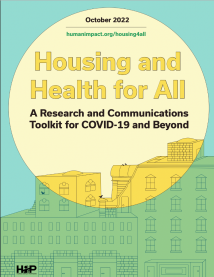
This new report from Stewards of Affordable Housing for the Future (SAHF) presents data on the impact that affordable housing can have on families health and well-being.

An initiative of University of Virginia and the Institute for Advanced Studies in Culture, Thriving Cities equips city stakeholders to measure what it takes to thrive in their community.

Get a 3D view of racial equity with a focus on performance, disparity, and impact.
1
Human Impact Partners (HIP) developed the Housing and Health for All: A Research and Communications Toolkit for COVID-19 and Beyond in partnership with housing justice organizers and advocates to bolster the ongoing housing and health sectors’ advocacy to build a more just and healthy future. The toolkit distills public health research into talking points and data access guidance that housing and health advocates can easily plug into their campaigns or communications.

The toolkit includes:
|
2
Building to Impact, a data based narrative platform from Stewards of Affordable Housing for the Future (SAHF), presents data on the impact that affordable housing can have on families health and well being.

SAHF and its members have long recognized the value of quality affordable rental homes, especially when enriched with services, in supporting health and wellness, economic mobility, increased opportunity and an improved quality of life for residents. In late 2013, with support from the Kresge Foundation, SAHF launched its Outcomes Initiative – a collaborative effort of the SAHF members to establish and utilize indicators related to resident outcomes. Building to Impact presents data from SAHF members as part of the first stage of the Outcomes Initiative.
Scroll to the bottom of the report to explore the data collected for SAHF’s Five Outcome Areas: Community Engagement, Education, Housing Stability, Financial Stability, and Health and Wellness.
Already, some evidence links service-enriched housing to improved outcomes for residents, including increases in income, assets, and rates of homeownership. A sense of safety and civic participation are also on the rise at some SAHF properties. Other data illustrates challenges and provides a baseline for measuring future growth. This initiative has contributed toward SAHF members’ efforts to conduct more comprehensive data collection and analysis, supporting their work to deliver better, more cost-effective programs. The indicator framework has also served as the basis for the Strong Families Fund, a Low Income Housing Tax Credit Syndication Fund offered by SAHF’s affiliate, the National Affordable Housing Trust (NAHT), with support from the Kresge Foundation and the Robert Wood Johnson Foundation and with Goldman Sachs as an investor.
The report uses data from two resources also featured on MeasureUp; the Distressed Communities Index and Enterprise’s Opportunity360.
3
An initiative of University of Virginia and the Institute for Advanced Studies in Culture, Thriving Cities equips city stakeholders to measure what it takes to thrive in their community.

Thriving Cities hosts a variety of tools to inform and equip all city stakeholders including the average resident, community leaders, and powerful institutions to tell the story of what it means to thrive in their community.
Try out their Indicator Explorer – an interactive tool structured around their Human Ecology Framework designed to help city stakeholders improve their neighborhoods.
You can sort the Indicator Explorer by Endowments, Interests, and Indicators.
In 2015 Thriving Cities picked three pilot cities to began research based on the Human Ecology Framework. Read the city profiles here.
The Community Field Guide is a tool for residents to create data visualizations and infographics to help tell their distinct story.
4
RACE COUNTS measures the overall performance, amount of racial disparity, and impact by population size of every county in California.

RACE COUNTS is an initiative launched by Advancement Project California, USC PERE, PICO California and California CALLS that includes a comprehensive online tool ranking all 58 counties by seven issue areas critical to California’s future to paint a comprehensive picture of racial disparity in California.
The seven key issue areas are:
RACE COUNTS maps racial equity in California using a 3D analysis of performance, disparity and impact:
Take a look at the full picture of state averages and county rankings
View the launch report and key findings
Find a full list of the partner organizations that informed this initiative.
5
The Prosperity Now Scorecard is a comprehensive resource for data on household financial health and policy recommendations to help put everyone in our country on a path to prosperity.
The Scorecard equips advocates, policymakers and practitioners with national, state, county and city data to jump-start a conversation about solutions and policies that put households on stronger financial footing across five issue areas: Financial Assets & Income, Businesses & Jobs, Homeownership & Housing, Health Care and Education. The Scorecard assesses all states on their relative ability to provide opportunities for residents to build and retain financial stability and wealth. The state outcome rankings are a measure of financial prosperity and how that prosperity is shared and safeguarded.
Try using the Scorecard by Exploring Data by Location or Exploring Data by Issue Area.
Also on the site you can find:
Newsroom: Find links to the latest news, information about our experts, state and national press releases, and more.
Methodology: Learn about the framework within which the Scorecard is conceived, the methodology for assigning outcome rankings and grades, our approach to assessing policy adoption.
6
Numerous resources have recently been released detailing the connection between safe, affordable housing and good health. We’ve curated a list of publications, websites, convening notes, slide decks and more to help you make the case for the housing-health connection.
Addressing the Impact of Redevelopment on Community Health in Seattle’s Yesler Terrace, 2017, Evidence for Action, Public Health Seattle and King County, Seattle Housing Authority, and Neighborcare Health
Affordable Housing Investment: A Guide for Nonprofit Hospitals and Health Systems, 2019, Urban Institute
ASTHO-CDC-HUD Convening Meetings Notes: Cross-Sector Partnership Models to Improve Health and Housing Outcomes, 2017, Association of State and Territorial Health Officials, Centers for Disease Control and Prevention and the U.S. Department of Housing and Urban Development
Health and Housing, Enterprise Community Partners, Inc.
Housing and Health: An Overview Of The Literature, 2018, Health Affairs
Health and Housing 101: Understanding the Intersections, 2016, Community Catalyst
Health Impact Assessment and Housing, Guidance for Health and Housing Professionals, 2016 Pew Charitable Trusts
Housing and the Role of Hospitals, 2017, American Hospital Association, Health Research and Education Trust, and Association of Community Health Improvement
Housing and Health: Exploring the Social Determinants of Health, 2011, Robert Wood Johnson Foundation
Housing as Health, 2017, Journal of the American Medial Association (JAMA) Forum
Innovative Models in Health and Housing, 2017, Mercy Housing and the Low Income Investment Fund
Leveraging Housing Vouchers to Address Health Disparities, 2017, American Journal of Public Health
Unstable Housing and Caregiver and Child Health in Renter Families, 2018, American Academy of Pediatrics
7
This short report by UCSF and the Build Healthy Places Network reviews selected research on how physical, service, and social conditions in a community can influence health, for better or worse.
A large body of research has linked neighborhood conditions with health, including physical conditions, available services, and social conditions. Extensive research shows that low-income and minority neighborhoods are more likely to experience harmful conditions and to lack health-promoting conditions. Although children may be particularly vulnerable to the health effects of living in a disadvantaged place, health effects can extend into adulthood. A sampling of research-based evidence is included.
8
This issue brief from the MacArthur Foundation’s How Housing Matters program describes what is known, and what research is needed, to better understand which neighborhood characteristics affect youth development and health.
George Galster, an expert on neighborhoods and urban planning, describes the various neighborhood factors researchers believe influence health, and how. He notes that a consensus is emerging that four neighborhood factors—social cohesion, social control, spatial mismatch, and environmental hazards—have the strongest effects on personal outcomes.
9
This issue brief from the Robert Wood Johnson Foundation examines the current evidence linking neighborhoods and health. It also reviews promising programs and interventions to make neighborhoods healthier places to live, learn, work, and play.
Just as conditions within our homes have important implications for our health, conditions in the neighborhoods surrounding our homes also can have major health effects. It explores the following questions:
• How can neighborhoods affect health?
• Are features of places really that important for health—or should we focus primarily on the individuals who live in them?
• Do all Americans have the opportunity to live in a healthy neighborhood?
• Could public and private policies improve neighborhoods in ways likely to improve America’s health?
The report provides examples of public, private, and joint public-private initiatives intended to make neighborhoods healthier.
10
These brief fact sheets from the Local Initiatives Support Corporation (LISC) provide overviews of the evidence on health and health-care issues that are important in low-income communities.
Created by the LISC Institute for Comprehensive Community Development, the five fact sheets focus on:
11
This toolkit, part of the Urban Land Institute’s Building Healthy Places Initiative, describes 21 evidence-based recommendations for improving health via the built environment. The recommendations are based on a rigorous literature review, with practical suggestions for implementing each.
The toolkit offers 21 “gold star” recommendations for promoting health in buildings and development projects. The toolkit is available digitally as a downloadable pdf, and as a one-page visual summary.
The recommendations cover:
A list of practical implementation strategies and best practices, grouped according to their available evidence base, supports each of the recommendations.
The recommendations and strategies are ranked by: